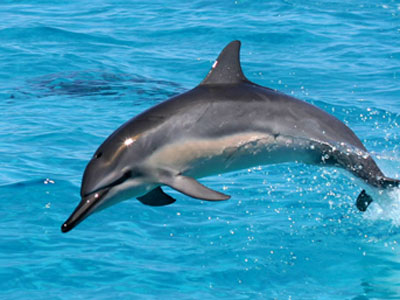
Myctophids or lanternfish at the deep scattering layer. Photo by OAR/National Undersea Research Program
Benoit-Bird's work has pioneered the use of acoustic tools to track the dolphins as they hunt. She presented a video of some of her data on a group of dolphins moving along in a line, looking for food. Their air bladders were clearly visible. The animals then encounter a school of fish that have come up to the surface. The dolphins begin to swim in a circle around the school, but incredibly they did so in pairs. Each pair circled the school at a constant depth, and pairs took turns moving into the school to feed, then returning to the perimeter. As each pair of dolphins retreated, the pair on the other side of the circle moved in.

Hawaiian spinner dolphin, Stenella longirostris longirostris, photo by Andy Collins
Did we doubt that dolphins are smart?
It was an amazing demonstration of behavior that is impossible to see without technological tools that give us a glimpse of the private lives of other animals. I wasn't the only one in the audience that was impressed. The swelling of respect and affection for the dolphins from the audience was palpable. Of course, dolphins are pretty likeable anyway. Ever the science nerd, I asked if anything was known regarding the social structure of these feeding groups, which number roughly 20 individuals. Not yet.
But the really interesting question is why there wasn't a person in that room who would argue that dolphins are not worthy of conservation- especially after the presentation. The connection was already there, and it had been strengthened.
How do we choose? Are marine mammals with complex social structure and communication more worthy than some other animal with neither? We would probably disagree if we thought about it. But it is the emotional connection that counts, the visceral identification with some other living being that brings us to consider another's needs even at the potential expense of our own.
As the world's resources are under ever greater pressure from human populations, we're going to have to make choices about what we will try to save. This is already true, although we rarely acknowledge it. Identifying some other living being as "other" allows us to fight wars, perpetuate injustice, and ignore the consequences of our choices. Understanding how we draw the lines among those who are "like us" and those who are not is going to determine who is going to be allowed entry into the metaphorical ark as the extinction crisis and climate change bear down upon us. If we can act with our heads as well as our hearts, we'll be more likely to save the crucial system parts required to sustain us.
No comments:
Post a Comment